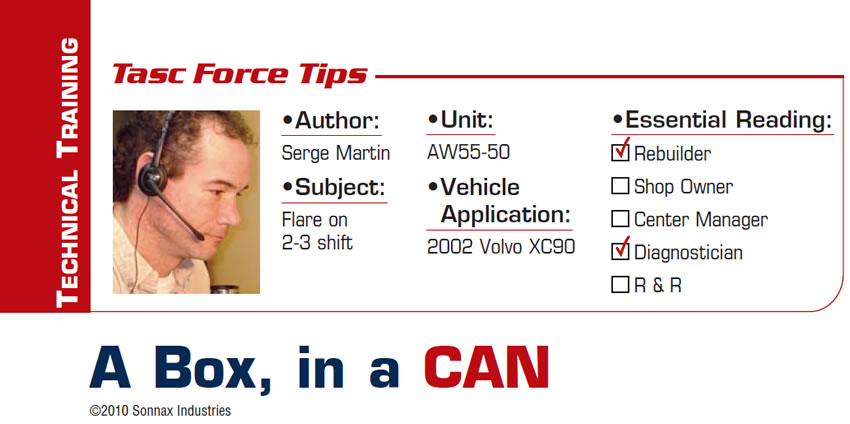
TASC Force Tips
- Subject: Flare on 2-3 shift
- Unit: AW55-50
- Vehicle Application: 2002 Volvo XC90
- Essential Reading: Rebuilder, Diagnostician
- Author: Serge Martin
One of our customers rebuilt an AW55-50 and had repeat complaints of a 2-3 shift flare. Everything on the transmission side of this complaint was corrected and rechecked. Everything on the valve-body and control side of the complaint was done, checked, verified and looked at again. Resets/relearns – you name it, they tried it. Eventually another valve body was tried, but the car continued to have the 2-3 flare.
With everything appearing to function perfectly, or at least being capable of it, the vehicle was sent to a dealer to attempt resetting the computer. It didn’t work; once more, the problem refused to go away.
Those of you familiar with 2002 Volvo XC90 models know they operate on a CAN (controller area network) system. If you are not yet familiar with CAN, think of it as shared lines of communication. The CAN system is the network for communication and control of just about everything that operates electronically throughout the entire vehicle. While scrutinizing this car to find the cause of the 2-3 flare, our customer did find something wrong with the vehicle’s rear brake lights: Two bulbs were burned out. He replaced the bulbs, but the brake lights still did not work. After some wiring-diagram research, he realized that the brake lights were controlled by a module and that the module was on the network.
Could it be as simple as something wrong in one computer preventing the reset of another computer operating on the same CAN? The only way to verify that was to find and repair the brake-system problem. While tracking the wiring for the brake lights, our customer found a little black box that did not appear in the wiring diagram. It was an aftermarket trailer-light adapter. Although they are not at all uncommon, the aftermarket brake box was totally unacceptable as far as the factory control module was concerned.
After installing a “factory” trailer box on the Volvo, the dealer was able to correct the brake-circuit fault in the control module and then successfully reset the transmission computer. Two-three shift flare gone: problem fixed.
The lesson here is not to be on the lookout for aftermarket electronics. The lesson is to remember that old rule about checking and clearing all codes and all systems. This has been a rule to follow for a long time on vehicles using multiple modules that share information, such as an engine controller and a transmission controller. It is even more important to remember this rule with a CAN system. Faults in one system may prevent a relearn in another, and there will be nothing to tell you the reset was not applied!

Serge Martin is technical director of Matech BTA Inc., Quebec, and a member of the Sonnax TASC™ Force (Technical Automotive Specialties Committee), a group of recognized industry technical specialists, transmission rebuilders and Sonnax Industries Inc. technicians.
©2010 Sonnax Industries













